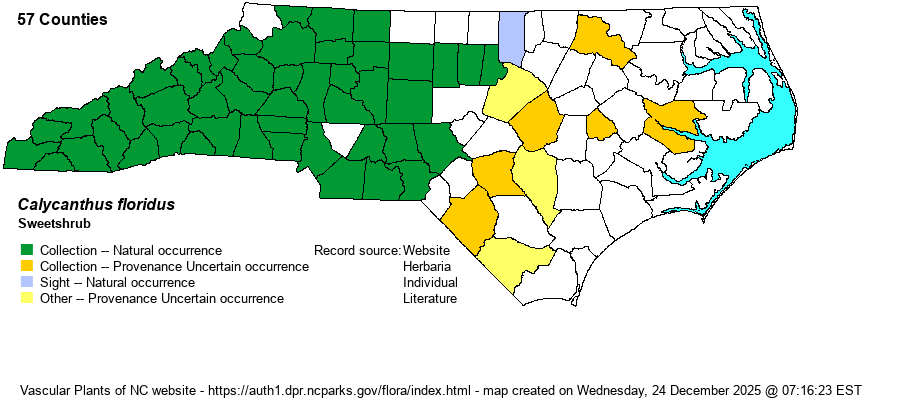| taxonName | relationship | relatedTaxonName | relatedTaxonRefText | relComments |
|---|
|
|
| Calycanthus floridus | > | Calycanthus floridus var. floridus | | |
| Calycanthus floridus | > | Calycanthus floridus var. floridus | Flora of North America (1993b, 1997, 2000, 2002a, 2002b, 2003a, 2004b, 2005, 2006a, 2006b, 2006c, 2007a, 2009, 2010) | |
| Calycanthus floridus | > | Calycanthus floridus var. floridus | Godfrey and Wooten (1979, 1981) | |
| Calycanthus floridus | > | Calycanthus floridus var. floridus | | |
| Calycanthus floridus | > | Calycanthus floridus var. floridus | | |
| Calycanthus floridus | > | Calycanthus floridus var. floridus | | |
| Calycanthus floridus | > | Calycanthus floridus var. floridus | Radford, Ahles, and Bell (1968) | |
| Calycanthus floridus | > | Calycanthus floridus var. floridus | | |
| Calycanthus floridus | > | Calycanthus floridus var. floridus | Wunderlin & Hansen Flora of Florida (3) | |
| Calycanthus floridus | > | Calycanthus floridus var. floridus | Ferry & Ferry (1987)=Y. | |
| Calycanthus floridus | > | Calycanthus floridus var. floridus | Ferry & Ferry (1987)=Y. | |
| Calycanthus floridus | > | Calycanthus floridus var. glaucus | Gleason and Cronquist (1991) | |
| Calycanthus floridus | > | Calycanthus floridus var. glaucus | | |
| Calycanthus floridus | > | Calycanthus floridus var. glaucus | Flora of North America (1993b, 1997, 2000, 2002a, 2002b, 2003a, 2004b, 2005, 2006a, 2006b, 2006c, 2007a, 2009, 2010) | |
| Calycanthus floridus | > | Calycanthus floridus var. glaucus | | |
| Calycanthus floridus | > | Calycanthus floridus var. glaucus | | |
| Calycanthus floridus | > | Calycanthus floridus var. glaucus | | |
| Calycanthus floridus | > | Calycanthus floridus var. glaucus | Wunderlin & Hansen Flora of Florida (3) | |
| Calycanthus floridus | > | Calycanthus floridus var. glaucus | Ferry & Ferry (1987)=Y. | |
| Calycanthus floridus | > | Calycanthus floridus var. laevigatus | Godfrey and Wooten (1979, 1981) | |
| Calycanthus floridus | > | Calycanthus floridus var. laevigatus | | |
| Calycanthus floridus | > | Calycanthus floridus var. laevigatus | Radford, Ahles, and Bell (1968) | |
| Calycanthus floridus | > | Calycanthus floridus var. laevigatus | Ferry & Ferry (1987)=Y. | |
| Calycanthus floridus | > | Calycanthus floridus | Fernald (1950) | |
| Calycanthus floridus | > | Calycanthus fertilis | Fernald (1950) | |
| Calycanthus floridus | > | Calycanthus fertilis | Gleason (1952) | |
| Calycanthus floridus | > | Calycanthus floridus | Small (1933, 1938) | |
| Calycanthus floridus | > | Calycanthus mohrii | Small (1933, 1938) | |
| Calycanthus floridus | > | Calycanthus fertilis | Small (1933, 1938) | |
| Calycanthus floridus | > | Calycanthus nanus | Small (1933, 1938) | |
| Calycanthus floridus | > | Calycanthus floridus var. oblongifolius | | |
| Calycanthus floridus | > | Calycanthus brockianus | | |
| Calycanthus floridus | > | Calycanthus brockiana | | , orthographic variant |
| Calycanthus floridus | > | Calycanthus brockiana | Ferry & Ferry (1987)=Y. | , orthographic variant |
| Source: Weakley's Flora |

